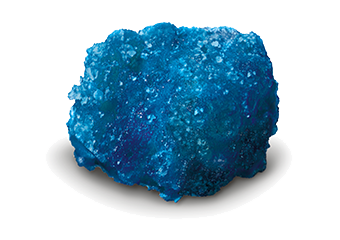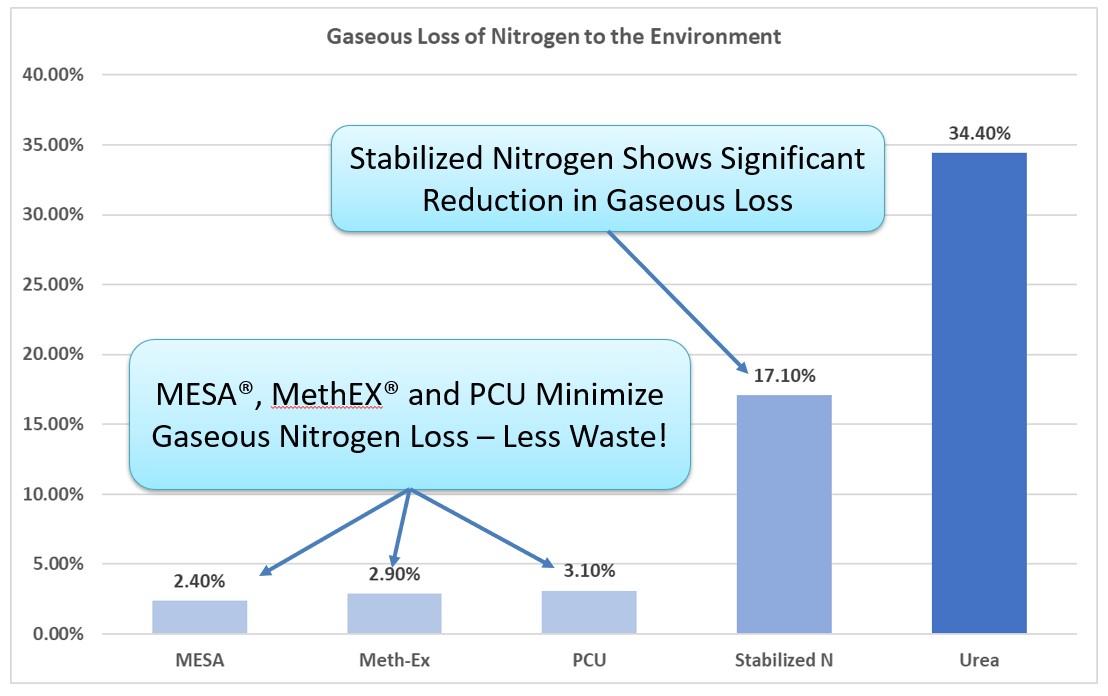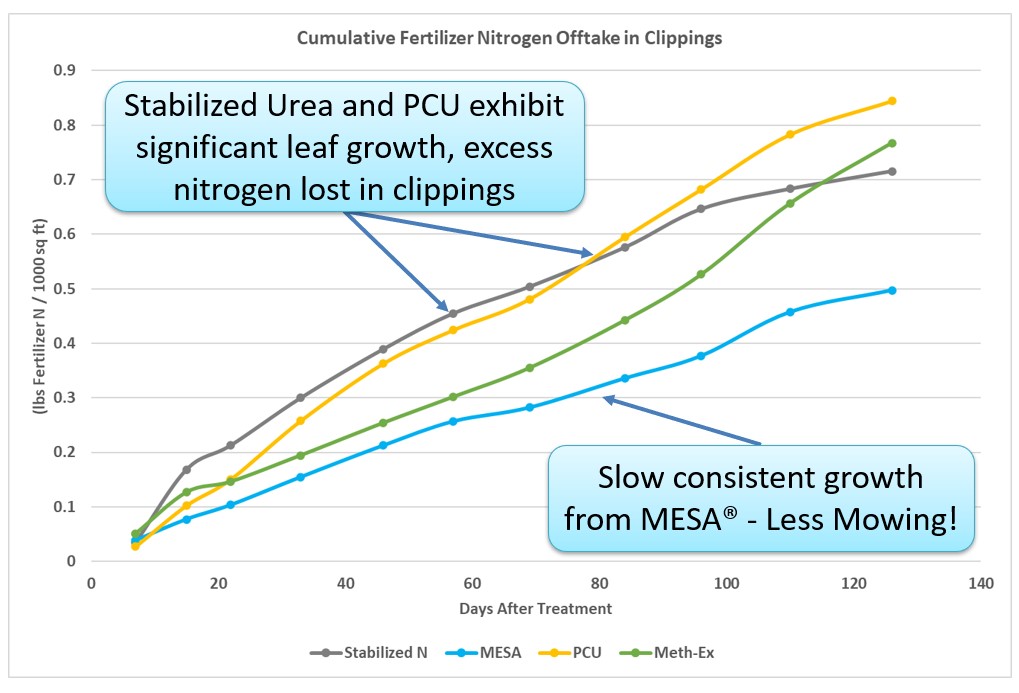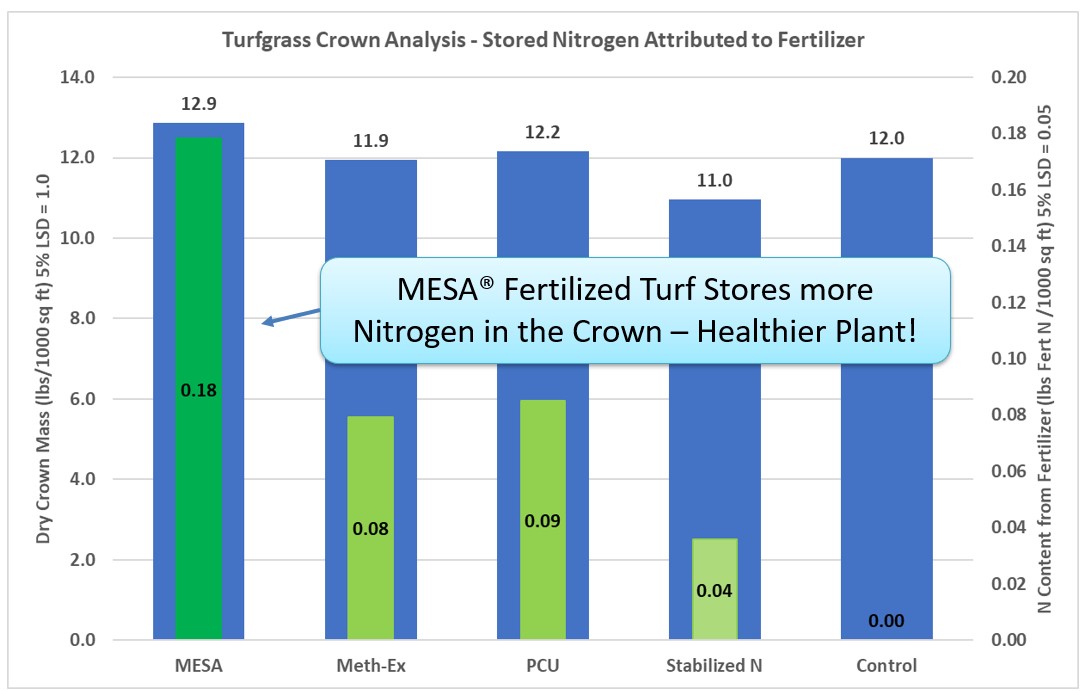MESA - Go Blue. Get Green.

MESA®, with its distinctive blue colored granule, is a preferred nitrogen source of both landscape and golf fertilizer applications due to its unique ability to deliver nitrogen in three different ways; through slow-release, quick-release and controlled release. MESA’s homogeneous particles infuse methylene urea and ammonium sulfate together to provide unsurpassed turf performance by delivering slow, consistent growth and dark green color without any surge growth that demands increased mowing. MESA’s established ability to provide both exceptional turf health and aesthetic appearance is directly attributed to how the plant simultaneously processes both nitrogen components of the particle.
In a recent Penn State University research trial, MESA was directly compared to other nitrogen sources to determine how the turf plant utilizes the released nitrogen to understand the fate differences between them. Put simply, the goal was to understand where the nitrogen from each nitrogen component ultimately ends up after it’s been applied.
Volatility – Gaseous Loss to the Environment

Immediately following application, the biggest nitrogen loss threat stems from volatilization, which is the natural process when ammonium is converted to ammonia gas that then gets released into the atmosphere. This loss occurs most frequently with straight urea. In this study, straight urea lost 34.4% of the applied nitrogen, while stabilized nitrogen was more efficient, but still lost 17.1%. MESA, by comparison, performed the best of all the nitrogen sources evaluated by losing only 2.4% to volatility.
This section of the study clearly illustrates that by minimizing volatilization, MESA is both highly efficient in getting into the soil where it can feed the turf and doesn’t significantly contribute to releasing ammonia gas into the atmosphere.
Nitrogen Loss in Clippings

When nitrogen is absorbed, it’s distributed throughout the entire turf plant largely based on the amount that has been initially taken up. When large amounts of nitrogen are immediately available, the leaf blades become super-charged which result in significant surge growth. When this happens, increased mowing becomes necessary. The nitrogen sent to the leaf blades then gets removed during mowing, meaning it’s then unavailable for other parts of the turf plant.
In this section of the study, both stabilized nitrogen and PCU exhibited significant leaf growth during the first 30 days after application, recording nitrogen loss of .30 lbs. N/M and .27 lbs. N/M respectively. At that same time, MESA’s nitrogen loss was held to only .15 lbs. N/M.
These research findings clearly demonstrate that MESA delivers slower, more consistent top growth by not having excess nitrogen distributed to the leaf blades. As a result, turf fed by MESA needs to be mown less often which greatly reduces the amount of overall nitrogen being spent in the clippings.
Stored Nitrogen in the Turf Crown
Arguably the most important part of the turf plant is the crown. It’s the connecting tissue between the roots and the shoots that produces buds that are the source of new tillers, roots, rhizomes, and stolons. In short, the crown is the center of activity driving the rest of the plant. Ensuring that the crown stays healthy and capable of fulfilling its critical functions is monumentally important to maintaining healthy turf.

In this section of the study, plants were harvested from each plot and the crowns were analyzed to determine how much of the applied nitrogen was retained in the crown. Stabilized urea recorded the retained nitrogen level in the crown at .04 lbs., while PCU registered .09 lbs. of retained nitrogen in the crown. MESA, however, registered a significantly higher amount of retained nitrogen in the crown with .18 lbs.
This study plainly shows that, due to its multiple nitrogen delivery methods, more nitrogen from MESA is being stored in the crown than any other nitrogen source. This elevated stored nitrogen from MESA allows the plant to maintain its health and recover from injuries faster than other nitrogen sources.
Evaluating MESA’s Performance
The goal of this study was to understand the roadmap that nitrogen takes within the turf plant comparing different nitrogen sources. There are several key take aways from the results of this study that have significant impact on choosing the most cost-effective, efficient, and environmentally friendly nitrogen sources. MESA has clearly demonstrated its industry leading position in each of these critical aspects.
Being cost-effective involves much more than simply taking a product’s price at face value. It more accurately considers how much of the nitrogen is reaching the plant, what the plant is doing with it, and what necessary maintenance practices will be required post-application. This study reveals that MESA isn’t being lost to volatilization and is ultimately reaching the plant to be available for uptake. It further shows that once plant uptake occurs, MESA nitrogen is not being sent to the leaf blades resulting in surge growth. Since there’s no surge growth, the amount of time needed to properly maintain the turf with excessive mowing practices is also reduced, resulting in less nitrogen being spent in the clippings. In this perspective, MESA has solidified itself as a highly cost-effective nitrogen source.
Efficiency in turf plant nitrogen fertility deals both with how the nitrogen is being distributed in the plant and where it ultimately ends up being stored for maximum benefit. Again, since MESA nitrogen doesn’t get pushed to the leaf blades due to its unique release process, it’s being utilized more efficiently in other areas. MESA’s significantly higher level of retained nitrogen in the crown illustrates that this is occurring. By having more nitrogen in the crown, MESA provides the plant with the energy it needs to develop new roots and shoots to maintain optimal health.
Being environmentally friendly, when it comes to nitrogen sources, means not losing nitrogen to the atmosphere or having it leached through the soil profile. As this study indicates, MESA had the lowest amount of nitrogen loss due to volatility, a feature directly correlated to the methylene urea element of the particle. That same methylene urea component of MESA is what virtually eliminates the possibility of leaching, since it must be broken down by microbial activity into small pieces that the plant can quickly absorb. In a time when environmentally friendly products are being sought out, MESA continues to illustrate both how and why it has been and continues to be a leading nitrogen source for turf professionals.
Conclusions
MESA is our leading nitrogen source for exceptional turf performance, efficiency and superior sustainability. Its unique ability to simultaneously deliver two forms of nitrogen in three separate ways, maximizes the plant’s ability to deliver aesthetic green-up and long-term healthy feeding. MESA’s unmatched proficiency in reaching and remaining in the plant after application, rather than being lost to the environment, illustrates its eco-friendly qualities and sustainable benefits. MESA is truly the ideal choice for today’s turf professional. Go Blue. Get Green.